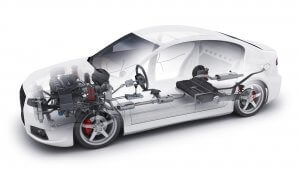Importance of Timing Belt
The timing belt is the conductor of your car’s engine. It maintains the beat and rhythm of the pistons and valves. You cannot exaggerate its importance to a healthy vehicle.
In more technical terms, this integral belt connects the engine camshaft and engine crankshaft, rotating them in sync. This allows the timing belt to make sure each cylinder fires at the right time. These perfectly timed explosions of fuel inside your engine’s combustion chamber, between the crankshaft’s pistons and the camshaft’s valves, propel your car down the road.
All this activity plays out behind the timing belt cover. A timing belt tensioner holds the thick, toothed timing belt tightly. This prevents it from skipping a tooth or “jumping time.” In some vehicles, the timing belt also operates the water pump, oil pump and injection pump.
Timing Belts vs. Timing Chains
Automakers began switching from chains to belts in the late 1970s and early 1980s. This resulted in lighter vehicles with better gas mileage. Additionally, it reduced the overall cost of automobiles.
Timing chains have recently begun to make a comeback because they have more durability. Your Vehicle Manufacturer’s Guide will reveal whether your vehicle relies on a belt or chain. For the record, many Luxury vehicles still employ timing chains.
When Should Timing Belt Replacement Be Done?
Often, drivers have no warning they need timing belt replacement. Timing belts have been known to fail long before the manufacturer’s recommended 60,000 mile or 100,000 mile mark.
However, some clues you may need a timing belt repair include a loss of power, loss of fuel economy, engine misfires, engine vibration, oil leaks from timing belt cover, a ticking noise in the engine or the engine simply refuses to start.
Additionally, an auto mechanic may notices signs of premature wear to the timing belt during an inspection. If this is the case, replace the belt immediately.
A convenient time to have timing belt replacement done is when other work requires taking off the timing belt cover and belt, such as installing a new water pump. In fact, replacing both the timing belt and water pump is often recommended to be done at the same time to save on auto shop labor costs.
Finally, it’s always a good idea when you purchase a used car to have the timing belt inspected.
Bringing in your vehicle to replace a timing belt as part of your vehicle’s maintenance schedule typically runs about $500 to $900. You will pay at least twice as much, however, if it breaks. Plus, this may result in extra damage to the valves, pistons or water pump.
DeBroux Automotive Provides Reliable and Trustworthy Timing Belt Replacement Service!
If your owner’s manual calls for a timing belt replacement or you notice signs you have a faulty belt, bring your car into DeBroux Automotive to undergo inspection. Our highly trained auto mechanics have earned a reputation for providing reliable and trustworthy work at a fair price in the Pensacola, Florida area since our family-run auto shop opened in 1989. We perform nearly every type of maintenance or repair work on all kinds of vehicles. Call us or come in today!
